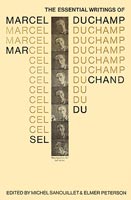|
 From 1922 the French surrealist poet Robert Desnos started using Duchamp’s pseudonym Rrose Sélavy in a series of aphorisms, puns, and spoonerisms. Desnos tried to portray Rrose Sélavy as a long-lost aristocrat and rightful queen of France. Aphorism 13 paid homage to Marcel Duchamp: “Rrose Sélavy connaît bien le marchand du sel” (Rrose Sélavy knows the salt seller well); in French the final words marchand du sel are an anagrammatization of marsel duchand with clear reference to the artist’s name. Note also that the essential writings of Duchamp, compiled by Michel Sanouillet and Elmer Peterson in 1973, are titled Salt Seller [Fig. 7]. The association of Duchamp with salt is doubtless informed by the layered meanings surrounding it. The connection of salt to Odysseus and Poseidon is given. In ancient Greece salt further represented friendship and hospitality. When Christ described his Apostles as “the salt of the earth” (Matthew 5:13) he alluded to their purity and strength in the face of corruption. In Shakespeare’s King Lear, a loving daughter is disowned by her father because she says she loves him only as much as the salt in her food. Much later the father is invited to a grand wedding feast where the food, prepared without salt, is bland and tasteless, at which point he realises his mistake. From 1922 the French surrealist poet Robert Desnos started using Duchamp’s pseudonym Rrose Sélavy in a series of aphorisms, puns, and spoonerisms. Desnos tried to portray Rrose Sélavy as a long-lost aristocrat and rightful queen of France. Aphorism 13 paid homage to Marcel Duchamp: “Rrose Sélavy connaît bien le marchand du sel” (Rrose Sélavy knows the salt seller well); in French the final words marchand du sel are an anagrammatization of marsel duchand with clear reference to the artist’s name. Note also that the essential writings of Duchamp, compiled by Michel Sanouillet and Elmer Peterson in 1973, are titled Salt Seller [Fig. 7]. The association of Duchamp with salt is doubtless informed by the layered meanings surrounding it. The connection of salt to Odysseus and Poseidon is given. In ancient Greece salt further represented friendship and hospitality. When Christ described his Apostles as “the salt of the earth” (Matthew 5:13) he alluded to their purity and strength in the face of corruption. In Shakespeare’s King Lear, a loving daughter is disowned by her father because she says she loves him only as much as the salt in her food. Much later the father is invited to a grand wedding feast where the food, prepared without salt, is bland and tasteless, at which point he realises his mistake.
Of course, salt has dual nature; it is required for life, but it can also bring death. It is essential for the human body to become chemically balanced, and for the muscles and nervous system to function. All bodily fluids are salty – blood, sweat, tears, saliva and sperm. The general consensus among experts is that a healthy adult should aim towards a daily intake of five or six grams of salt to maintain a good balance. Salt overdose, however, brings about death. This is why the Dead Sea is lifeless. In many respects Duchamp’s notorious silence and seeming abstinence from art may be considered to be an overdose of salt. The painter Jeanne Reynal said of him: “He gave up life while still alive… He is very much alive. But he can observe the impact of his work, while he is alive, but as if he were dead.” (Drot 1963). |

